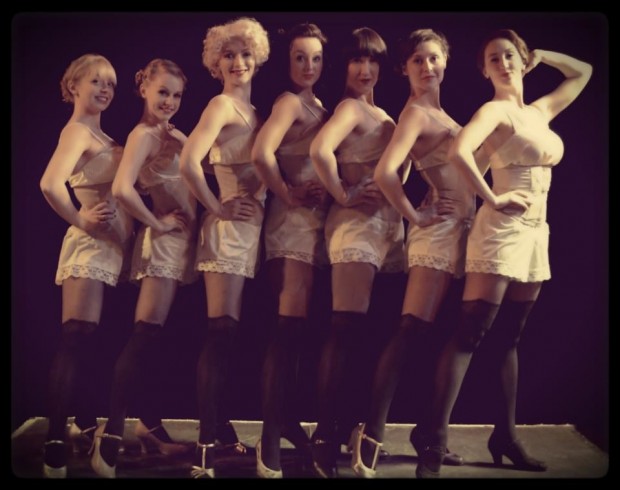You have no items in your cart. Want to get some nice things?
Go shopping
Halbwelt Kultur, which has just completed its first run at New Wimbledon Studio as parts of the Fresh Ideas programme, hones in on an intensely tumultuous period of history: that of the Weimar Republic. With 2013 marking 80 years since the end of this era, the timing of this production seems apt.
It begins with an unmistakeably decadent call to arms and a summing-up of what we should come to expect from this play: “the German is gross in his immorality. He likes his halbwelt, his underworld pleasures, to be devoid of any kultur, of any refinement.” This is a quote originating from Netley Lucas, who was very much a product of the underworld he described; he was a fraudster and a thief who made a career out of plagiarism and lying. It is very befitting that his quote should therefore take centre stage in this play that deals with the amoral, seedy Berlin of the 1920s.
Fascinatingly though, Halbwelt Kultur looks at Germany during this period not directly through the general state of its economy or society (both of which were in dire straits to say the least). Instead, it takes a more novel approach by telling the stories of seven especially extraordinary and influential women of the era. A series of short vignettes focus in on Blandine Erbinger, Claire Waldoff, Marlene Dietrich, Rosa Luxembourg, Valeska Gert, Anita Berber and finally Gabriele Tergit. These are all women whose names continue to resound in our modern consciousness. However, the vignettes that particularly attracted my attention were those dedicated to Clare Waldoff, Rosa Luxembourg and Anita Berber.
Waldoff had a very unique and groundbreaking act in the cabaret scene – she would cross-dress on stage, transforming from a woman to a man. I was struck by the freedom that cabaret gave her – the kind of freedom that would have been denied her in all other aspects of social and political life. The empowerment that Waldoff experienced was something that was only made available to her in this time in which she lived. It appears that sordid, decadent Berlin in the 1920s afforded women a remarkable amount of liberation, if only in the bars and clubs of the time. Women could get away with almost anything in cabaret – and certainly much more than they ever would have been allowed to in polite society.
Yet strong female socio-political commentators also emerged out of this era – and even though higher forces attempted to stifle their voices, they still secured their place in history. I am referring specifically to two other women we gain an insight into in Halbwelt Kultur – Rosa Luxembourg, the socialist powerhouse, and Gabriele Tergit, who began her career as a reporter and, as time progressed, wrote anti-fascist pieces as well as a socially critical novel. She paid for this dearly: the SA stormed her home and she was forced to flee to Palestine.
Kathleen McNamara succeeded in playing Tergit with all the poignancy the role called for. I also thought Rosa Luxembourg’s vignette (played here by Alma Fournier-Carballo) was well-done; the lyrics of her song quite cleverly encapsulated her political theories. After all, the complex concepts and ideas in her writing certainly could not have been easy to transmute into song form. I felt this production carried this off very well.
However, in my opinion, a truly stand-out performance was Samantha Clark’s portrayal of Anita Berber. Berber was multitalented – a dancer, actress and writer – yet she was notorious for her drug abuse and alcoholism. This vignette was a compelling dance piece, in which the discordance of the music mirrored the instability and turmoil of her existence. The evident turmoil of her life was heightened further by her disjointed dancing. It was made amply clear that her life was one composed of great extremes, in which ecstasy and pain were often juxtaposed and even, at times, interwoven. The choreography was also impressive in amplifying her strong personality.
I think it is important to spend a moment in comparing Halbwelt Kultur with Cabaret, as Halbwelt Kultur is so clearly heavily influenced by the latter. The brilliance of the musical film Cabaret is to be found in its surmounting tension, as Nazism grows to grip the whole of Germany. This political element is present even when it is somewhat obscured by the decadent excesses and behaviours of the main characters. I would say there is much more darkness to Cabaret than there is in Halbwelt Kultur: any references to Nazism or political upheaval in Halbwelt Kultur seemed to be rather diminished by the brashness of the cabaret.
Because of the inevitably difficult balance to strike in highlighting the fragile socio-political situation of the Weimar Republic on the one hand, and the debauched excesses and freedoms of the cabaret scene on the other, I was inclined to give Halbwelt Kultur some leniency in sometimes seeming to have a lack of depth. After all, seven short vignettes can only give you the essence of the Weimar Republic, not a full picture. As an overview of the time in which it was set, I believe Halbwelt Kultur succeeded quite well. The audience certainly seemed impressed by the performances of the seven women and the play as a whole.
All in all, Halbwelt Kultur could have benefitted from perhaps being extended into a longer piece. However, it worked well at what it was trying to do and I found its concept to be innovative and intriguing.
For more information on Halbwelt Kultur, and to see where it will be next performing, check the PK Productions website.

About Ana Malinovic
Ana graduated from Warwick University with a BA in English and American Literature in 2010. Her dissertation was centred on dystopian elements in the fiction of Kafka. She enjoys uncovering innovative works of fiction by a diverse range of authors. She also spends much of her time roaming around London's arts and culture scene overexcitedly. Check out her blog





Encapsulating performance by @almafoca in Halbwelt Kultur !! | Litro London review https://t.co/CrVJYg4B9i
One more piece on @HalbweltKultur on @LitroMagazine https://t.co/PiIboB9on7